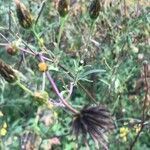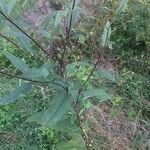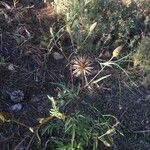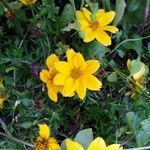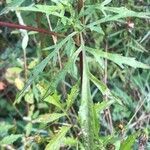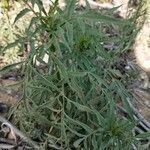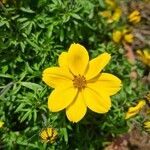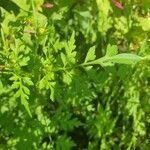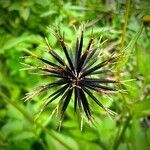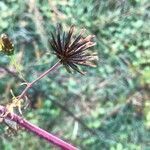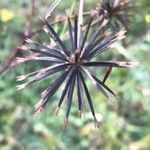Annual herbs, (15-)30-100(-150+) cm. Petioles 20-50 mm; leaf blade orbicular-deltate to ovate or lanceolate overall, (20-)30-70+ × (20-)30-60+ mm, (1 or)2(or 3)-pinnatisect, ultimate lobes obovate or lanceolate, 15-45+ × 10-25+ mm, both surfaces usually glabrous, sometimes hirtellous, bases truncate to cuneate, ultimate margin entire, sometimes ciliolate, apices rounded to acute or attenuate. Synflorescences of solitary capitula or ± corymbose; peduncles (10-)20-50(-100) mm. Capitula radiate or discoid; calycular bracts (7 or)8(-10), linear, 3-5 mm, ± appressed, abaxially usually glabrous, margin ciliate; involucres ± campanulate, 5-7 × 3-4(-5) mm; phyllaries 8-12, lanceolate to linear, 4-6 mm. Ray florets absent or 3-5+; lamina yellowish or whitish, 1-2(-3) mm. Disk florets 10-20(-30+); corollas yellowish to whitish, 2-3 mm. Achenes red-brown, outer weakly obcompressed, 7-15 mm, inner ± 4-angled, linear to linear-fusiform, 12-18 mm, faces 2-grooved, often tuberculate-hispidulous, margin not ciliate, apex ± attenuate; pappus of (2 or)3 or 4 erect to divergent, retrorsely barbed awns 2-4 mm. Fl. Aug-Oct. 2n = 24, 72.
Annuals, (15–)30–100(–150+) cm. Leaves: petioles 20–50 mm; blades rounded-deltate to ovate or lanceolate overall, (20–)30–70+ × (20–)30–60+ mm, (1–)2(–3)-pinnatisect, ultimate lobes obovate or lanceolate, 15–45+ × 10–25+ mm, bases truncate to cuneate, ultimate margins entire, sometimes ciliolate, apices rounded to acute or attenuate, faces usually glabrous, sometimes hirtellous. Heads usually borne singly, sometimes in ± corymbiform arrays. Peduncles (10–)20–50(–100) mm. Calyculi of (7–)8(–10) linear bractlets 3–5 mm, ± appressed, margins ciliate, abaxial faces usually glabrous. Involucres ± campanulate, 5–7 × 3–4(–5) mm. Phyllaries 8–12, lanceolate to linear, 4–6 mm. Ray florets 0 or 3–5+; laminae yellowish or whitish, 1–2(–3) mm. Disc florets 10–20(–30+); corollas yellowish to whitish, 2–3 mm. Cypselae red-brown, outer weakly obcompressed, 7–15 mm, inner ± 4-angled, linear to linear-fusiform, 12–18 mm, margins not ciliate, apices ± attenuate, faces 2-grooved, often tuberculate-hispidulous; pappi of (2–)3–4, erect to divergent, retrorsely barbed awns 2–4 mm. 2n = 24, 72.
Stout annual herb 25–120 (–160) cm high; stems erect, glabrous, rarely minutely setulose. Leaves petiolate, very variable, bipinnatifid or bipinnate, rounded-deltoid to ovate or lanceolate in outline, 35–170 mm long, 20–120 mm wide, with ultimate lobes bluntly toothed or entire, sparsely hispid on veins below or glabrous; lobes linear to ovate, dissected. Capitula ovoid, 5–10 mm diam.; outer involucral bracts linear to narrowly lanceolate, not dilated, 3–5 (–7) mm long, shorter than or equalling florets, ±acute or blunt, glabrous or with few short fine hairs; inner bracts linear-lanceolate, usually deep purplish brown with indistinct longitudinal veins, glabrous or with outermost shortly and finely hairy. Ray florets (0) 3–5, yellow; ligule 1–2 (–3) mm long. Achenes slightly dimorphic, linear, slightly compressed, red-brown to black, usually glabrous below, sometimes with a few antrorse barbs on upper part; outer achenes 8–10 mm long; inner achenes 10–18 mm long. Pappus awns (2) 3 or 4, erect or V-divergent, 2–4 mm long.
Glabrous or minutely hairy annual 3–17 dm; lvs 4–20 cm including the 2–5 cm petiole, mostly 2–3 times pinnately dissected, the ultimate segments tending to be rounded; heads narrow, disciform, the disk only 4–6 mm wide at anthesis, the short, ochroleucous rays not surpassing the disk; outer invol bracts 7–10, linear, ± acute, not evidently expanded upwards, shorter than the inner; achenes linear, tetragonal, narrowed above, often sparsely hairy, 10–13 mm, or some of the outer shorter; pappus of (2)3 or 4 yellowish awns; 2n=24, 72. Moist to fairly dry, disturbed habitats; Mass. to Fla., w. to Neb., Calif., and Mex., e. Asia. July–Oct.
Annual herb, up to 1.5 m high. Leaves opposite, rarely alternate towards apex; blade ovate in outline, up to 200 mm long, bipinnate; leaflets very narrowly ovate or linear, margins serrate to almost entire, usually pubescent in lower parts; petiole 10-60 mm long. Heads radiate, up to 10 mm in diameter, in lax, paniculate cymes, pedunculate. Involucral bracts biseriate, imbricate. Receptacle paleate. Flowers: ray florets small, neuter, yellowish; disc florets bisexual, yellow; Jan.-May. Fruit with cypsela black, linear-fusiform, tetragonal, glabrous or sparsely hispid towards apex. Pappus of (2)3 or 4 awns.
Annual herb, 0.05-1.50 m high; stems branching. Leaves opposite, glabrous or hairy; ovate in outline, bipinnatisect, leaflets lanceolate in outline, margins often lobulate or lobulate-dentate, sometimes dissected to midrib. Capitula in lax, few-headed corymbs; involucral bracts oblong or subspathulate. Ray florets 3-5, small, yellow. Disc florets yellow. Flowering time Jan.-Apr. Cypselae linear, angled, ribbed, somewhat dimorphic.
Annual herb, up to 1.5 m high. Leaves bipinnate, leaflets lanceolate in outline, usually lobulate. Pappus awns (2-)3-4. Flowers yellow.
Nearly glabrous or pubescent on the stems and leaves when young
An erect, sometimes bushy annual herb 1-4 ft. high
Ray-florets yellow, few or rarely absent.
